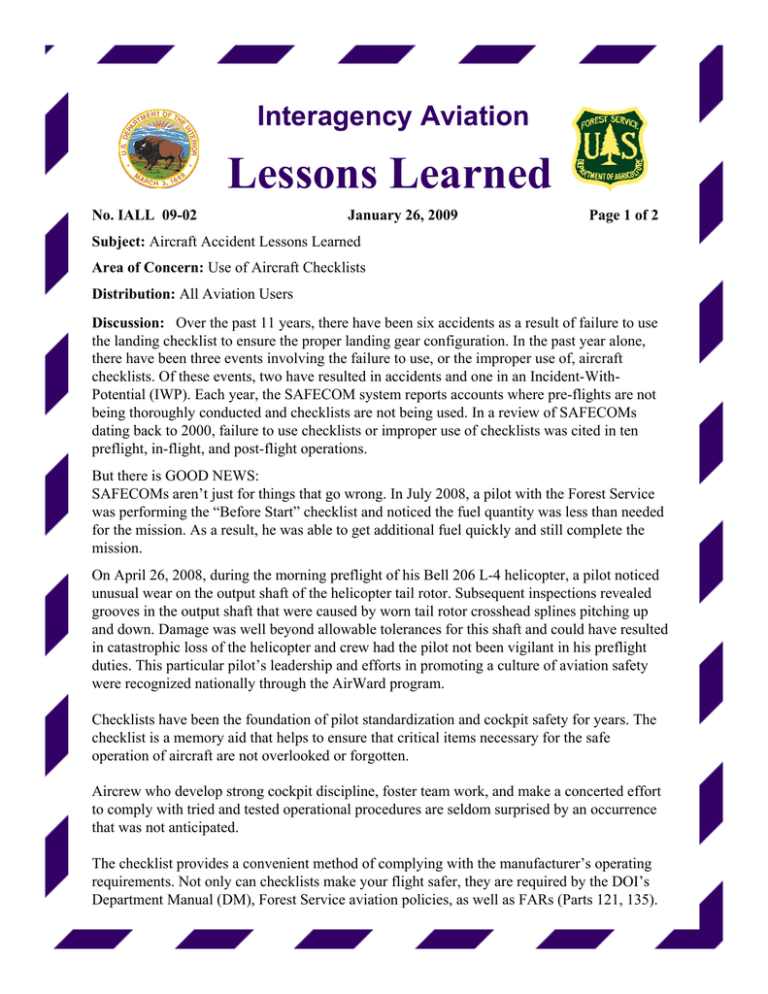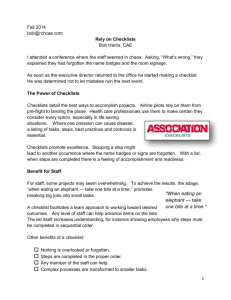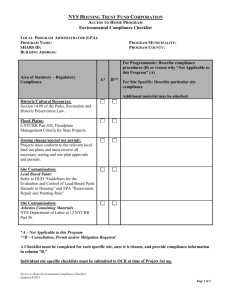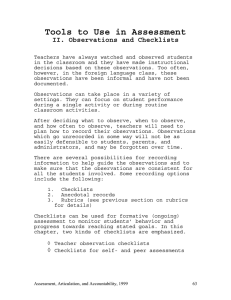Lessons Learned Interagency Aviation
advertisement

Interagency Aviation Lessons Learned No. IALL 09-02 January 26, 2009 Page 1 of 2 Subject: Aircraft Accident Lessons Learned Area of Concern: Use of Aircraft Checklists Distribution: All Aviation Users Discussion: Over the past 11 years, there have been six accidents as a result of failure to use the landing checklist to ensure the proper landing gear configuration. In the past year alone, there have been three events involving the failure to use, or the improper use of, aircraft checklists. Of these events, two have resulted in accidents and one in an Incident-WithPotential (IWP). Each year, the SAFECOM system reports accounts where pre-flights are not being thoroughly conducted and checklists are not being used. In a review of SAFECOMs dating back to 2000, failure to use checklists or improper use of checklists was cited in ten preflight, in-flight, and post-flight operations. But there is GOOD NEWS: SAFECOMs aren’t just for things that go wrong. In July 2008, a pilot with the Forest Service was performing the “Before Start” checklist and noticed the fuel quantity was less than needed for the mission. As a result, he was able to get additional fuel quickly and still complete the mission. On April 26, 2008, during the morning preflight of his Bell 206 L-4 helicopter, a pilot noticed unusual wear on the output shaft of the helicopter tail rotor. Subsequent inspections revealed grooves in the output shaft that were caused by worn tail rotor crosshead splines pitching up and down. Damage was well beyond allowable tolerances for this shaft and could have resulted in catastrophic loss of the helicopter and crew had the pilot not been vigilant in his preflight duties. This particular pilot’s leadership and efforts in promoting a culture of aviation safety were recognized nationally through the AirWard program. Checklists have been the foundation of pilot standardization and cockpit safety for years. The checklist is a memory aid that helps to ensure that critical items necessary for the safe operation of aircraft are not overlooked or forgotten. Aircrew who develop strong cockpit discipline, foster team work, and make a concerted effort to comply with tried and tested operational procedures are seldom surprised by an occurrence that was not anticipated. The checklist provides a convenient method of complying with the manufacturer’s operating requirements. Not only can checklists make your flight safer, they are required by the DOI’s Department Manual (DM), Forest Service aviation policies, as well as FARs (Parts 121, 135). Interagency Aviation Lessons Learned No. IALL 09-02 January 26, 2009 Page 2 of 2 LESSONS LEARNED Recommendations: Here are a few tips for using checklists successfully: 1. Make a habit of using checklists consistently. 2. Do your checklist when the workload is low. 3. Avoid distracting conversation when performing checklists. 4. Encourage a team approach to cockpit checklist tasks, such as call and response methods. 5. Treat any checklist interruption as a red flag that could cause you to miss a critical item. If you get interrupted, start over. Aircrew…use your checklists ! /s/ Robert Galloway Robert Galloway Aviation Safety Manager /s/ Ron Hanks Ron Hanks Chief, Aviation Risk Management and Training Systems






